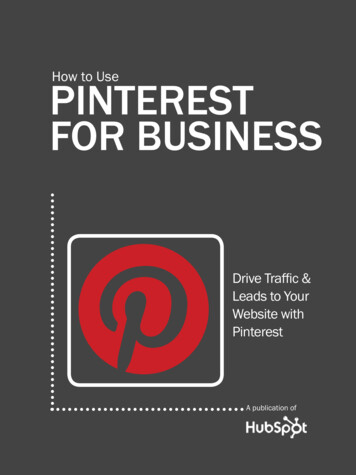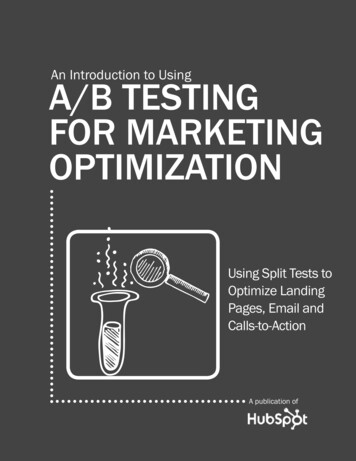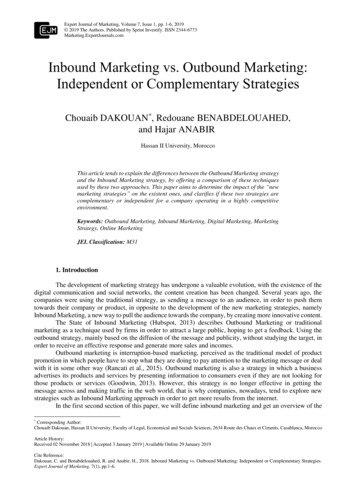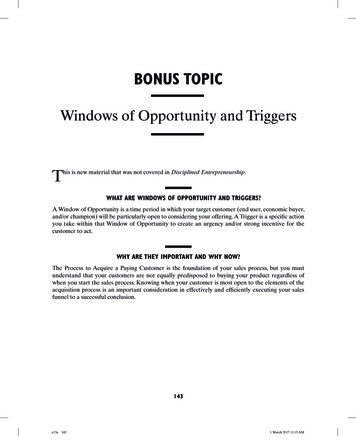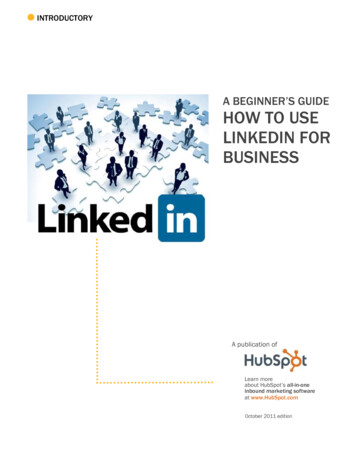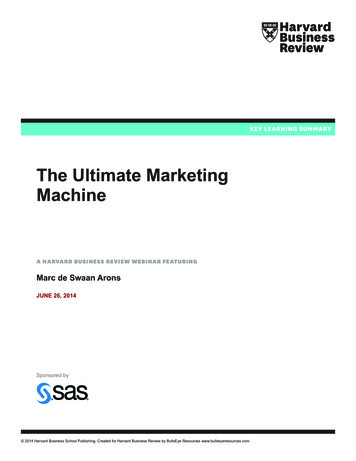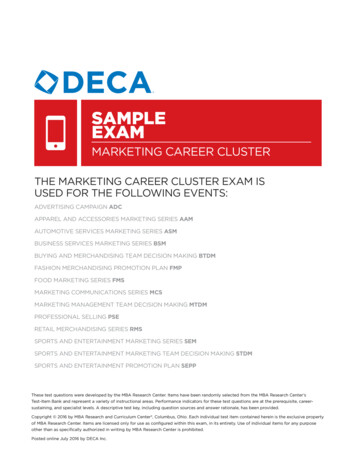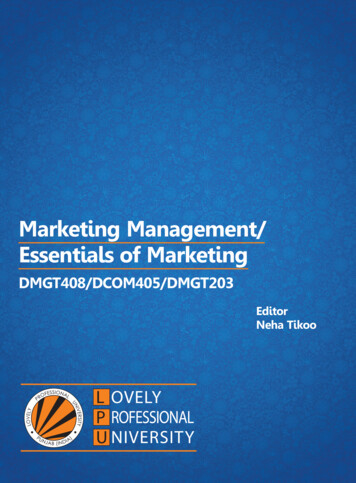
Transcription
ONLINE MARKETING OPPORTUNITY REPORTOnline Marketing Opportunity Report:Social Media, Blog, and Search EngineActivity by IndustryHubSpot.comShare on Twitter1
ONLINE MARKETING OPPORTUNITY REPORTContentsWhere Should YOU Market Online? .3Step 1 - Determine Where the Conversation is Happening for Your Industry .4How to Interpret the Overall Online Activity Chart. 5Be as Specific as You Can – Variation Exists Within Industries . 5Step 2 - Measure the Detailed Activity and Competition .7Step 3 – Formulate a Marketing Strategy for Each Channel .9Search Engines . 9Blogs. 10Twitter. 11Facebook . 12LinkedIn . 13YouTube . 14Take Action: Additional Resources to Become an Expert . 16Appendix - Industry Opportunity Analysis Details in Alphabetical Order . 17About HubSpot . 50HubSpot.comShare on Twitter2
ONLINE MARKETING OPPORTUNITY REPORTWhere Should YOU Market Online?You have finite resources and nearly infinite possible online marketing channels. Where should your companyput its marketing dollars and effort to work? Do you wonder if it is worth the effort to start a Twitter account or aFacebook page? Are you having trouble going beyond basic search engine optimization (SEO)? It can bedifficult to know if it is worth the time and money to expand the online marketing for your business and eventougher to figure out where the conversation is happening.HubSpot has gathered exciting data and developed measurement methods to help you answer theseimportant marketing questions.HubSpot.comShare on Twitter3
ONLINE MARKETING OPPORTUNITY REPORTStep 1 - Determine Where the Conversation isHappening for Your IndustryWhere is the online activity for your industry? Is it focused in search engines? Blogs? Social media? To findout, we used a proprietary algorithm to analyze 33 keywords that describe some common industries. Theresults are summarized in the graph below; find the industry that best matches your own.Overall Online ActivityVideo estaurantReal EstatePublishingPharmaceuticalOilNon ProfitIndustry KeywordMusicMovieMiningSearch EnginesMarketingManufacturingBlogsLawyerSocial MediaInsuranceHotelHealth onCell sing0%10%20%30%40%50%60%70%80%90%100%Relative ActivityHubSpot.comShare on Twitter4
ONLINE MARKETING OPPORTUNITY REPORTHow to Interpret the Overall Online Activity ChartThe graph above is a measure of where the relative online activity is for a given industry. Because it isfundamentally comparing apples to oranges (tweets to blog posts, etc.), it is about displaying trends andilluminating where activity is occurring, not about exact absolute numbers. Some industries are dominated byactivity in social media, while others are dominated by queries in search engines or blog activity.Examining the keyword phrase “non profit,” for example, shows that currently the vast majority (over 80%) ofonline activity in the space is taking place in social media. More explicitly, at this point in time, conversationsare taking place that contain the keyword “non profit” in social media. Comparably, few people go to searchengines and look for the term “non profit.”Looking at another term, “travel,” most of the online activity (about 75%) is happening in search engines.Relatively speaking, people are more inclined to do a search for travel than they are to blog about it. This is thecomplete opposite of the term “non profit.”Don’t Just Chase ActivityDo not simply look for the most active area for your industry and conclude that the optimal place to market isthe most active space. As with many things in life, it is possible that great benefits can be accrued by followingthe less travelled path. The Formulate a Marketing Strategy for Each Channel section of this ebook covers, indetail, how to react to the data for each of these channels.Be as Specific as You Can – Variation Exists Within IndustriesHubSpot explored some groupings by larger categories of industries of the above chart and found there canstill be significant differences within larger industry groups. The takeaway is that it is important to be as specificas possible when defining your industry. The chart below that shows hospitality/leisure industry groupingsdemonstrates the variability that can exist within a group.Industry KeywordHospitality/Leisure Industries Overall Online ch EnginesBlogsSocial Media0%10%20%30%40%50%60%70%80%90%100%Relative ActivityHubSpot.comShare on Twitter5
ONLINE MARKETING OPPORTUNITY REPORTNext, we continued our analysis of relative online activity by examining the breakdown of social media. For thisanalysis, we looked at the top four social media channels for marketers: Twitter, Facebook, LinkedIn, andYouTube. (See the 2010 State of Inbound Marketing webinar for more info on popular social media channels.)Looking across the same 33 industries, the following graph breaks out the relative activity for each keyword.Social Media ActivityVideo estaurantReal EstatePublishingPharmaceuticalOilNon ProfitIndustry h onCell sing0%10%20%30%40%50%60%70%80%90%100%Relative ActivityHubSpot.comShare on Twitter6
ONLINE MARKETING OPPORTUNITY REPORTUsing the social media data, we can start to understand which channels are being used most actively for eachindustry.Examining “video games” first reveals that YouTube is by far the most active channel, accounting for abouttwo-thirds of the social media activity (note that we are only considering Twitter, Facebook, LinkedIn, andYouTube in this analysis and that this analysis is a relative comparison of activity levels for each keyword).“Manufacturing” activity, on the other hand, happens primarily on LinkedIn, followed by a significant presenceon Twitter.Step 2 - Measure the Detailed Activity and CompetitionIs the activity enough to make a difference to your business, and can you get mindshare?Now that you have identified the industry most relevant to your business and you understand the basic activitylevels, go one layer deeper into the data. To do this, perform the keyword research you would do for anysearch engine optimization program, but expand your search to look at blogs and social media. What does thismean? Measure the absolute activity levels (similar to the number of queries per month in search engines) andthe level of competition (how hard it will be to gain mindshare). Details about the specific metrics to measureand the methodology to follow are outlined in this ebook.We have gathered this data for all of the 33 industries presented in this ebook and summarized it in theappendix. To illustrate how to read these industry summaries, the analysis for the keyword “software” is shownbelow, followed by an explanation of how to interpret the information. Go to the appendix for the samedetailed analysis on each industry keyword.HubSpot.comShare on Twitter7
ONLINE MARKETING OPPORTUNITY REPORTKeyword Opportunity AnalysisWhere Is the Overall Online Activity?Where Is the Social Media Activity?SearchEnginesYouTubeTwitterAnalysis nline Opportunity COMPETITION(out of 100)Search EnginesMax Possible Search Traffic per Month: 183,000Search Engine Competition: 96BlogsBlog Posts per Month With Keyword: 42,813Blog Competition: 51Blog Posts With Keyword in Title: 6,454,237TwitterTweets per Month With Keyword: 1,335,152Twitter Competition: 57FacebookFans of 10 Most Relevant Pages: 69,883Posts per Month With Keyword: 125,944LinkedInGroups With Keyword in Description: 10,717Members of Top 10 Groups With Keyword in Description: 341,571Questions and Answers Containing Keyword per Month: 810YouTubeVideos Described by Keyword: MillionsViews of 10 Most Relevant Videos: 699,668HubSpot.comFacebook Competition: 33LinkedIn Competition: 61YouTube Competition: 50Share on Twitter8
ONLINE MARKETING OPPORTUNITY REPORTOverall Activity SummaryThe first two graphics simply display in pie chart format the same information that was displayed in theprevious charts that looked at the relative activity across all 33 industries. The pie charts offer another way toview the same information.Absolute Activity and CompetitionThe next stage of the analysis focuses on two core concepts that are essential to understanding the amount ofonline opportunity that exists for a given industry or keyword:-Absolute Activity – how many actions take place for a keyword in a given channelCompetition – how much competition exists for a keyword in a given channelThe activity numbers were recorded at a single point in time and represent a snapshot that will change. Theraw activity numbers are directly recorded and then extrapolated in some instances to give estimates for longertime frames such as a month. The competition rating is generated using proprietary HubSpot algorithms thatgive a measure of how crowded or saturated a particular channel is for a given keyword. A competition scoreof 50 represents an average level of competition, with anything lower representing below average competition,and anything above 50 representing above average competition.The data can be used to gain a better understanding of how much opportunity exists for a given keyword andhow many competitors are creating content in each channel for a given keyword. It is not meant to imply thatall of the numbers are directly comparable. For example, just because there are more tweets per month thanLinkedIn questions does not necessarily mean that Twitter offers more opportunity. Instead, the data can beused to formulate a marketing strategy for each of the channels. The next section of this ebook will explore indetail how to interpret the data and formulate a strategy.Step 3 – Formulate a Marketing Strategy for EachChannelUnderstanding how to formulate a strategy around this data is the most important section of this ebook.Interpreting activity levels and competition incorrectly can lead to misguided online marketing strategies. Forexample: Just because LinkedIn activity is low for a particular keyword does not mean you should avoidmarketing on LinkedIn. It may mean just the opposite. This chapter will give step-by-step guidance on how tocreate a winning marketing strategy for each marketing channel.Search EnginesPursuing keywords that have massive traffic but are extremelycompetitive is a losing strategy for all but the biggest of onlinecompetitors. For small and medium sized businesses, a winning keyword strategy usually involves creating afamily of keywords that strike the right balance between having reasonable levels of traffic and reasonableHubSpot.comShare on Twitter9
ONLINE MARKETING OPPORTUNITY REPORTlevels of competition. This topic is covered in depth in the ebook, 2010 Online Marketing Blueprint, so it willnot be covered in depth here. If you are interested in getting more guidance on this topic, we highlyrecommend the 2010 Online Marketing Blueprint.BlogsInterpreting the blog data is very similar to interpreting search engine data. In general, it isgood to target keywords that have significant activity, but if the competition is too high, youmay want to start by targeting some lower hanging fruit.There are two primary methods by which people read blogs: through search engine resultsor through subscriptions via RSS or email. Of course, any piece of content can spread virally through socialmedia, but that is frequently a secondary effect that comes after the content is read by a regular blogsubscriber.Blog Search ResultsThe first method of reading a blog (clicking on a search result) corresponds to the metrics around searchengine data interpretation. Activity for a particular keyword must exist if you expect to receive any visitors, butyou will also be competing directly with the content generated by competing blogs. Again, striking the rightbalance between activity levels and competition is critical.Blog SubscribersThe second method of reading a blog (subscribing via RSS or email) is not perfectly correlated with searchengine dynamics, but highly related. Ultimately, people can only read so many blogs. High activity levels aregood because they indicate interest in the topic, but competition will impede your ability to gain subscribers.Blog Strategy Summary--In summary, the strategy for expanding your footprint in the blogosphere is similar to the strategy forsearch engines. Find activity levels that are high enough to move the needle for your businessand ideally for keywords that have below average competition. Establishing a first moveradvantage in areas where competition is low and activity is reasonable can result in success.How will you know if activity levels are high enough for your business? Some basic math can guideyou, but experimentation remains key. Are there only a few dozen existing blog posts for your keyword?HubSpot.comShare on Twitter10
ONLINE MARKETING OPPORTUNITY REPORT-You probably need to broaden your target keywords, because the potential readership will just be toolow to generate a meaningful number of leads for your business. Are there tens of thousands of blogposts per month for your keyword? People would not be writing tens of thousands of blog posts permonth if nobody was coming to the blogs to read them. These blogs might have thousands of readers,but can you compete?Analyze, create some content, experiment, and try again until you find the right blend of activity andcompetition.TwitterThe strategy for executing a marketing strategy on Twitter and the notion of competitionis significantly different than the notion of competition for search engines or blogs.What to Do if Activity and/or Competition Is HighLike blog posts, your tweets are read in two primary ways: either from subscribers (or more precisely followers)of your Twitter stream or from a search in a search engine or Twitter (tweets do show up in search results).Subscribers or “Followers”People are not afraid to subscribe to vast numbers of Twitter accounts. Unlike blogs, which people can onlyread so many of, Twitter can still be useful even if a person subscribes to thousands of Twitter feeds. The keydifference is that Twitter is about speed, not completeness. It’s alright to subscribe to thousands of Twitterfeeds because you don’t need to read every tweet. Following a large number of accounts relevant to yourinterests ensures that you are reading the most current information when you choose to see what is going onin the world. This is an extremely important nuance because it is what allows you to gain subscribers even in ahighly competitive industry. Many are not making either-or decisions when it comes to who they want to follow;they are looking to find everyone that is writing about the subjects that interest them.Tweets in Search EnginesFor search engines, the algorithms that rank tweets in Google or Twitter are moving targets and thereforeimpossible to completely predict. That said, there are three elements that will likely be factors in consideringhow to rank tweets: importance, relevance, and “recency.” Recency is a reference to how recently content wasposted.Importance can be determined by a number of factors, including how many followers an individual has onTwitter and how many retweets a particular tweet receives. For this metric, competition will certainly make itmore difficult to get traffic.HubSpot.comShare on Twitter11
ONLINE MARKETING OPPORTUNITY REPORTRelevance is simply a measure of how relevant a tweet is to a keyword search, and this is a factor that will notreally be impacted by the level of competition. You have the power to make your tweets as relevant as youwant to whatever audience you want.“Recency” is slightly different, and this is one element that sets Twitter apart from other marketing channels.One of Twitter’s greatest assets is its ability to display what is happening in real time. This is something that isaffected by competition; if you tweet about something and a thousand other people follow suit, then your tweetwill be buried in some sense. However, for some period of time, you can be the most recent information sourceon a topic. And nothing is preventing you from tweeting frequently on a topic so that you stay the most recentsource of information. (Read the blog article “Use Twitter to Rank #1 in Google in Less Than 5 Minutes” to geta better understanding of how this works.)Again, we will not try to predict the exact importance of each of these factors in determining future searchresults, but they are all important. The important takeaway is that the “recency” element enables people wholack significant influence to be found on Twitter even for very competitive keywords.What to Do if Activity Is LowIf activity levels are low, it may still be worth tweeting about a particular keyword. Because tweets get highpriority for some types of searches, you may be able to get traffic outside of Twitter. Depending on competition,it is possible that getting a tweet to rank in the search engines will be easier than attempting to get a web pageor blog post to rank. If that tweet can then drive traffic to a page that is relevant to your business, you will beable to sneak around all the businesses that focus solely on SEO. It may require fairly active effort to keep yourtweets appearing in the search engines, but maintaining an active Twitter account will build your following overtime and continuously increase your reach as a marketer. As with any marketing tactic, you should experimentand then adjust based on the results.Twitter Strategy SummaryHigh levels of activity and competition are not necessarily bad things on Twitter. To a certain extent, they willlimit your ability to spread your message until you gain authority, but in many ways it is an encouraging sign ofinterest. Look for activity and competition and then just start tweeting.FacebookAnalyze ActivityThe first step toward building a marketing strategy for Facebook requires an analysis of theabsolute activity levels. Is anyone on Facebook talking about your keywords? If thenumbers are low, you should either target broader keywords or develop a family ofkeywords with lower activity numbers that can drive enough traffic to still be relevant to yourbusiness. Ultimately, with more than 500 million users worldwide, Facebook likely has anaudience for your product if your product has an audience at all. The task is finding the keywords thatpeople are using to describe your product or service. While many have traditionally seen Facebook as morerelevant to B2C businesses, there is also an opportunity for B2B players as well. Understanding the keywordspeople are using on Facebook that are relevant to your business will enable you to craft messages thatresonate with the fans you will hopefully develop over time.HubSpot.comShare on Twitter12
ONLINE MARKETING OPPORTUNITY REPORTFacebook CompetitionThe notion of competition in Facebook is similar to the notion of competition in Twitter. Users of Facebookdon’t necessarily mind becoming fans of a large number of pages. Much like Twitter, it is not necessary to seeevery post by every friend or page. Additionally, businesses typically create pages for their brands rather thanaround a particular keyword. In short, there is room for every company to have a home on Facebook.On Facebook, the notion of competition is most useful when considered in a more traditional business context.More specifically, competition is less about the sense of advertising visibility and more about the difficulty ofwinning over customers. If competition is high, you should still be able to reach a large number of customers,but you may need to work especially hard to stand out from the crowd. If competition is low, simply beingpresent on Facebook may be enough to start engaging potential customers.Facebook Strategy SummaryIt is likely that you have potential customers on Facebook regardless of your business type. Find keywords thathave activity high enough to be meaningful to your business so that you can use the right messaging whentalking about your company and its products or services. Monitor the level of competition to determine theeffort you will need to invest to differentiate your business. Facebook will provide you the eyeballs if you usethe right communication, and the right offer will allow you to stand out from the competition.LinkedInLinkedIn is another unique marketing channel that allows two very distinctstrategies. To examine these strategies, you should asses the two mostdominant areas of LinkedIn for marketers: LinkedIn Groups and LinkedInAnswers. The strategy for marketing in LinkedIn Groups and Answersdepends on the activity levels and the levels of competition.High Levels of Activity and Weak CompetitionIf you have stumbled upon an industry or niche with high activity levels on LinkedIn but relatively weakcompetition, you may want to start a new group. Weak competition for high traffic keywords means that themarket is being underserved, and with diligent effort, you may be able to get an industry group off the ground.HubSpot.comShare on Twitter13
ONLINE MARKETING OPPORTUNITY REPORTIf no group exists, you will have a tremendous first mover advantage. If there are groups with low levels ofengagement, you may still be able to come in as a second mover and dominate the conversation.High Levels of Activity and Strong CompetitionWhen performing an online marketing opportunity analysis, as usual, high levels of activity are a good sign.However, if levels of competition are also high, you may need to look for more fertile ground further down thekeyword list. LinkedIn Groups are all about targeting broad industry keywords rather than your particular brand.By creating a group for a term that describes your industry, you will be attracting a broader group of peoplethan you would if you just used your brand name. The caveat to this is that if competition is significant for yourkeyword, they have probably already created one or more groups dedicated to this keyword. On LinkedIn, thefirst mover advantage is critical, and it will be difficult for you to gain mindshare with a group if several vibrantgroups already exist for the topic.If the competition is too high for a keyword of interest to your business, you can employ two strategies: First,you can look for a less competitive keyword that is still relevant to your business. Second, you can focus onengagement.When considering a less competitive keyword strategy, if the activity levels are high enough to be relevant toyour business, starting a more focused group can be a winning strategy. A smaller but well-targeted group ofindividuals you can interact with on LinkedIn can be extremely effective at generating leads. The secondtechnique that can be employed (which does not necessarily exclude the first) is to focus on engagement.Simply asking and responding to questions in the LinkedIn Answers feature is a way to engage LinkedInmembers without having your own group. Additionally, actively participating in discussions in the most relevantgroup for your industry will enable you to position yourself as a thought leader. Over time, as you buildinfluence and credibility on LinkedIn, people will want to know more about you and your company. Thatcredibility can be attained even if you aren’t the owner of the group you actively participate in.LinkedIn Strategy SummaryUse activity and competition levels to determine whether it is best to start a new group or engage an existingLinkedIn Group or LinkedIn Answers.YouTubeThere are two primary ways people will find a video that you post on YouTube: throughform of a search or through viral sharing of the video. These two mechanismsfundamentally drive the strategic decisions around marketing on YouTube.HubSpot.comShare on Twittersome14
ONLINE MARKETING OPPORTUNITY REPORTHigh Levels of Activity and High Levels of CompetitionUnless you produce a viral video, much of your traffic will come from some form of a search. The implication isthat the strategy for YouTube defaults back to mimic the search strategy. It is a great sign if there is significantactivity in YouTube for your keyword, but it will be difficult to get a video to rank well in search (be it onYouTube or in traditional search engines). Targeting more attainable keywords may give you better results.The wrinkle to the search strategy is viral sharing. If your company has significant reach through email, socialmedia, your blog, or any other means, you will have the ability to promote a video without it ranking insearches. If the video is good enough, you may be able to get enough interest in the video for it to go viral andultimately rank well thanks to the number of accumulated views (the number of video views and commentssignificantly impact the rankings in search results).Producing a viral video that targets competitive keywords is a huge win, but it is more of an all or nothingstrategy. If the video does not go viral, it will likely sit in obscurity receiving relatively little search traffic.Low Levels of ActivityIf the level of activity in YouTube for your target keywords is too low to be meaningful to your business, you willneed to broaden the scope of your appeal. If there is any online interest in your keyword topic, then there willbe people willing to view your video. The challenge will be to reframe the content or marketing of your video tohave a wide enough appeal to get the video noticed. Targeting less specific keywords is one way to do this.Another method that works especially well for video is to relate your content to a more enticing theme.Comedy, for example, can dramatically increase the visibility of your video. A comedic video about pest controlcould potentially reach far more people who are interested in pest control than a straightforward video aboutpest control. As long as you are speaking to people who still might have some interest in your topic, thisapproach can yield successful results.YouTube Strategy SummaryIf you can’t ensure that your video will rank for relevant searches, either reframe the content or try to go viral.HubSpot.comShare on Twitter15
ONLINE MARKETING OPPORTUNITY REPORTTake Action: Additional Resources to Become an ExpertRecognizing if there is opportunity for your business to market online is critical for building an effective onlinemarketing strategy. Too many businesses cling to ineffective outbound marketing techniques because that iswhat they have done in the past (regardless of success). Diving into online marketing with no direction can alsobe a disaster. Fundamentally understanding online activity levels and competition for each potential marketingchannel is critical to developing a robust strategy.To get a better understanding of how to use all of the marketing channels discussed in this ebook, HubSpotoffers a wealth of free resources to get up to speed quickly. Specifically, we would recommend the followingfree resources:To learn more about harnessing Twitter -Twitter for Marketing and PRTo learn more about using YouTube - How to Use Online Video for Inbound MarketingFor everything you need to know about Facebook - Facebook for Business Marketing HubFor everything you need to know about LinkedIn - LinkedIn for Business Marketing HubTo better understand how search engines view your website - Website GraderFor everything you need to know about blogging – Business Blog Marketing HubIf you are looking for more information about investigating and leveraging the strategies outlinedin this ebook, we encourage you to request an Inbound Marketing Assessment with one ofHubSpot’s specialists. We are always working on new tools to help you market your businessbetter, and we would love to hear from you!HubSpot.comShare on Twitter16
ONLINE MARKETING OPPORTUNITY REPORTAppendix - Industry Opportunity Analysis Details in Alpha
ONLINE MARKETING OPPORTUNITY REPORT HubSpot.com 10 Share on Twitter levels of competition. This topic is covered in depth in the ebook, 2010 Online Marketing Blueprint, so it will not be covered in depth here. If you are interested in getting more guidance on this topic, we highly recommend the 2010 Online Marketing Blueprint. Blogs
